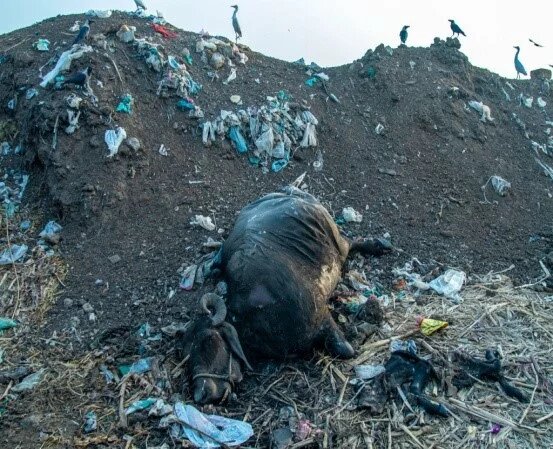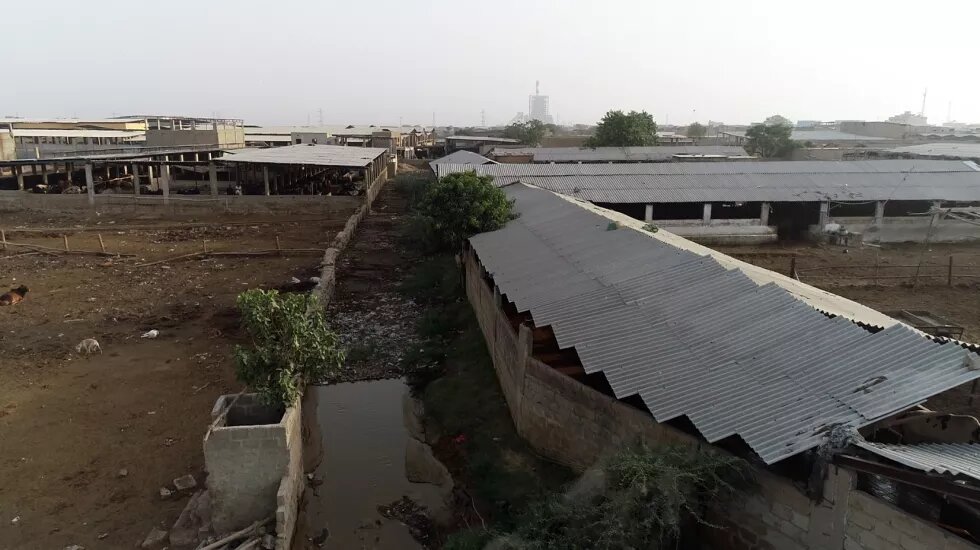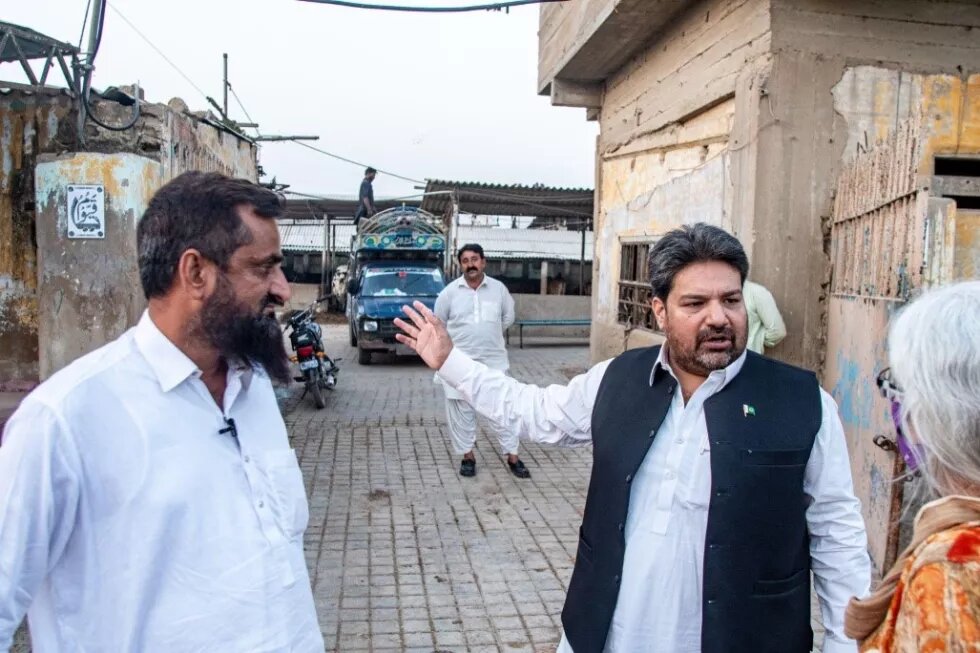
An ambitious project to convert cattle dung to fuel for buses may improve Karachi’s pathetic transport system, check heavy pollution and restore soil fertility.

Cattle Colony, located in Landhi in the eastern part of Pakistan’s biggest city and commercial hub Karachi, is a world unto itself. Roads that are not really roads, houses and buildings encroaching on those space. The most prominent thing you see there, however, is dung. Cattle dung! Mounds and mounds of it...
It is heaped along the roads, it is choking the drains, flying in the air, and getting into the respiratory system with each whiff of breeze that spreads it into the atmosphere after being pulverised into powder form under the wheels of vehicles.
No marks for guessing how much of it flies into the open containers of the milk in which it is decanted! Or what is the addition of the bacteria from the carcasses of the animals rotting on the heaps as they die due to the polluted environment.
"There is so much pollution. It is bad for the animals, and bad for us. There are respiratory and skin diseases. Our cattle get foot and mouth disease. There is a daily mortality rate of almost 300 cattle heads."
Yasmin Barkat, member of the Dairy Farmers Association
This pollution does not just stay on the road. A huge volume of water is used to wash the cattle pens, and all the cow dung is washed into the drains, explains by Abdul Hameed, vice president of the local Dairy Farmers Association. Besides the fresh water supplied by the municipality, people have also dug bore wells to extract underground water; they spend money on the extractive process as well as on the diesel motor pumps, which bring the water up.
The gradient lets the water flow out but the organic waste clogs the drains and the surface seems full of solid matter.
And all these drains lead right into the Korangi creek where it floats on the surface for miles. Children from the nearby settlements swim in this water. They dive into it and when they come up, they have fistfuls of dung instead of sea shells!
There are clear streaks of black and red in the sea water; black, because of the mix of effluents of the informal industries dumping their untreated liquid waste, while there is a red streak of blood coming from the slaughter house near the Cattle Colony.
This has killed much of marine life in the creek. The fisher folk living alongside it in Ibrahim Hyderi and Rehri villages do not get fish from here… to eat or sell. Now they have to contend with shrinking profit margins as they have to spend more on the diesel for their boats and go out further and further, and for a longer period of time, with a lot more supplies, into the open sea for their catch.
Many projects had been planned in the past to deal with this double jeopardy. These plans had almost reached fruition, and two such projects that would have utilised this cow dung as a source of power fell through at the last moment.
However, the globally growing realisation on the need to cut emissions as a means of combating climate change, combined with the imperative of creating a buffer against fuel price volatility gave a new impetus to put in place a bio-methane project that could deliver multiple benefits.
Despite being one the lowest emitters in the world, as a responsible nation, Pakistan has committed to further reductions. Other than this commitment, at a local and provincial level, there was a dire need to tackle the problem of solid waste management as well as the impacts of pollution the cattle colony was contributing to.
The numbers, as shared by Shakir Gujjar, president of the Dairy and Cattle Farmers Association (DCFA) of Pakistan are enough to give an indication of the scale and magnitude. According to him, there are over 300,000 cattle heads belonging to about 3,500 livestock farms spread over 3,000 acres of the colony. Over 6,000 tonnes of dung is dumped in the sea daily, he says.
Gung ho about the dung!
Such phenomenal numbers gave birth to an idea of a project of using this cattle dung to power buses that would be running on the Red Line of Bus Rapid Transit (BRT) plan drawn out for the sprawling metropolis of Karachi, whose over 20 million inhabitants were without any sustainable urban transport system in the public sector.
Just one year ago, Bloomberg had reported that Karachi had the worst transportation system in the world. Crumbling of the government sector transportation system allowed the growth of the private operators, who were woefully inadequate at meeting the demands of a growing population.
It also spurred the growth of smaller private vehicles and public transportation vehicles, known as minibuses, and two wheelers, contributing to the traffic congestion on roads, and in turn, leading to poor air quality due to fuel emissions.
Consultations had gone on for many years where it was agreed that the only way to ease the pressure on the roads was to use a mix of transportation solutions, including rail and a fleet of modern buses.
However, this required a mega outlay of financial resources, and a physical upheaval in the city to lay down the structure.
Laying down of the path itself has led to devil of the “3 D” – Demolitions, debris, displacements – and uprooting of trees, which the Red Line project has committed to offset at a ratio of 1:5 to augment the green cover of a city that falls way short of numbers considered to be adequate on a per person basis.
Multiple donors and financial institutions were sought by the government for the revamping of the transportation infrastructure of the city.
For implementing the BRT system for Karachi, and for its Red Line, the Green Climate Fund was approached and presented the integrated project that would provide emissions free transport and at the same time reduce the environmental hazards being caused by the cattle dung.
Explaining the approach, Malik Amin Aslam, special advisor to the former prime minister on Climate Change, said: "The said project is the first transport project in the world to be approved by the Green Climate Fund (GCF) and it comes with multiple environmental and economic benefits.
“It is part of the U$ 550 million funding for project. The rest is through Asian Development Bank (ADB), Asian Infrastructure Investment Bank (AIIB) and French Development Agency (French AFD J), and partially by the Government of Pakistan. All of these are lined up for confirmation. The GCF approval is coming after detailed scrutiny, and it gave it a ‘Gold Standard’ endorsement, which definitely facilitates an early financial closure."
TransKarachi has been designated as the implementing company by the government to manage the Red Line on which about 200 buses will be running on cattle dung power. Land acquisition for the bio-methane plant by the Government of Sindh has already been done.
Because of the availability of indigenous fuel for these buses, price variability in fares will be controlled without resorting to subsidies, which have been a critical point of concern in the other public transportation projects now running in Lahore, Islamabad and Peshawar.
In a city as big as Karachi where sustainable transport solutions are few and far between, the planners are confident that there will be no capacity and usage issues as it is likely to directly benefit more than 1.5 million passengers.
The BRT is going to fill the gap of a huge unmet need. This is just one of the benefits embedded into the project. The data sheet on the ADB website speaks of ancillary benefits like gender mainstreaming, which would include safe, economical and comfortable public transportation for women, the absence of which was a deterrent in their joining the workforce.
On the climate change mitigation front, the zero emissions project will demonstrate the scalability of the waste to energy concept.
The BRT will be using only about 40 per cent of the total volume of waste being produced at the Cattle Colony in Landhi and its success can spur conversion of the other public transportation vehicles onto this fuel instead of imported, expensive and uncertain options. This is why this project is also associated with hope for a better way of managing public transport fleets by freeing up the resources tied to import of expensive fuel, and use it for the maintenance of the buses.
"Karachi has been an unfortunate city in many ways. We have witnessed its public transport system deteriorating over two decades. The BRT Red Line is a project one of its own kind. There is so much that this project will offer this city, if it is implemented the way it was conceived and designed, it could put this city back on track."
Ashar Lodi, Exponent Engineers (Consultants on BRT Red Line)
| Project at a Glance |
|---|
|
"The Karachi BRT Red Line Project is designed as a third generation BRT system, which will provide off corridor accessibility through direct services. The project is the first of its kind in Pakistan with façade-to-façade development along the corridor, including uplift of historical sites, no land acquisition and most importantly, zero carbon emissions and zero requirement of subsidy due to its bio gas component. When completed, the red line is projected to have a daily ridership of 300,000 passengers."
Wasif Ijlal, CEO TransKarachi
While experts are looking at the nuts and bolts of the financials and land acquisition and profitability of the project, Shakir Gujjar, as a representative of the community having its entire stakes in the Cattle Colony, has his eyes set on higher things.
He sees not just the pollution elimination from and financial injection into his community, but is confident that the promises made to them by the Annual Development Programme (ADP) and Government of Sindh to provide access to health, education and better living conditions to the people living and working here will materialise.
Gujjar has his eyes on a bigger dream: That of the by-product from the biodigester, which will be the rich organic manure and slurry. The manure will help restore and enrich the fertility of the soil of the country, already compromised by the use of chemical fertiliser. As a representative of farmers, he recalls the days when the cattle dung was carted away for use by the farmers of the hinterland of Karachi.
Encroachment of the built up area of the city made the rich farmlands of Malir and Gadap area disappear. As a result, the market for organic manure vanished. Gujjar hopes the realisation of the cattle dung having the power to not only run buses but to grow fresh food from the enriched soils will kick-start the demand for manure, which can be transported to all parts of Pakistan through the revival of the railways as a goods carrier.
The liquid slurry from the bio-methane plant can be used in places in close proximity but the manure can be carted through the railways. There is hope in his eyes and conviction in his words when he mentions the potential of poop power!
Being a farmer’s representative, Shakir Gujjar is looking for the upliftment of his community. But once this project is implemented fully, there are expectations that it may serve as a model for similar solutions, small and large scale, considering that Pakistan is a large livestock owning country.









